Unrecognised and unmet physical health problems in a national cohort of very low birthweight young adults and controls
Brian A. Darlow 1 3 , Julia Martin 1 , L. John Horwood 21 Department of Paediatrics, University of Otago PO Box 4345, Christchurch 8140, New Zealand
2 Christchurch Health and Development Study, University of Otago, Christchurch, New Zealand
3 Corresponding author. Email: brian.darlow@otago.ac.nz
Journal of Primary Health Care 11(1) 32-38 https://doi.org/10.1071/HC18044
Published: 3 April 2019
Journal Compilation © Royal New Zealand College of General Practitioners 2019.
This is an open access article licensed under a Creative Commons Attribution-NonCommercial-NoDerivatives 4.0 International License.
Abstract
INTRODUCTION: Young adults are often reluctant to seek medical attention. Compared with full-term controls, very low birthweight (<1500 g; VLBW) young adults may have more health problems.
AIM: To assess the frequency of unrecognised or unmet physical health needs during a comprehensive health and welfare assessment of a national cohort of VLBW adults born in 1986 compared with full-term controls.
METHODS: The VLBW cohort (n = 229; 71% of those alive) and controls (n = 100) aged 27–29 years were assessed in one University Hospital over 2 days. Physical health assessments included growth, respiratory function, blood pressure, echocardiogram, renal function, blood tests and an interview. Cranial MRI scans were performed on 150 VLBW adults and 50 controls. Significant unrecognised or unmet health needs were defined as including a body mass index (BMI) >30 plus raised fasting insulin >80 pmol/L; any two of moderate respiratory obstruction, or reduced diffusing capacity, or being a regular smoker; cardiovascular: hypertension or abnormal echocardiogram.
RESULTS: Among the VLBW cohort and controls; 61% versus 73% (P < 0.05) rated their overall health as very good or excellent. A general practitioner (GP) referral letter was sent for 44% VLBW adults and 38% controls, concerning metabolic problems in 20% and 17% respectively; respiratory problems in 12% and 4% (P < 0.05) respectively; cardiovascular problems in 14% and 12% respectively; abnormal renal function in 7% in both groups; and anaemia in 3% and 5% respectively.
DISCUSSION: Unrecognised or unmet health needs were frequent in both VLBW young adults and controls. Respiratory problems and hypertension were more frequent in the former. Continuity of care is important for VLBW adults who require a regular GP. GPs should routinely ask about gestation and birthweight and VLBW graduates should volunteer this information.
KEYWORDS: Blood pressure; cardiorespiratory health; obesity; primary health care
| WHAT GAP THIS FILLS |
| What is already known: Adolescents and young adults are often reluctant to see a primary health-care physician and often consider themselves healthy even when displaying symptoms, but there are few data about this from New Zealand. |
| What this study adds: A physical health assessment of former very low birthweight young adults and term-born controls found unrecognised and unmet physical health needs were frequent in both groups (45% and 38% respectively), although respiratory problems and hypertension were more common in very low birthweight adults. |
Introduction
Adolescents and young adults are known to often be reluctant to seek medical attention and to have unmet health needs.1 The New Zealand Health Survey 2016–17 for the age band of 25–34 years shows 59.8% men and 79.3% women (69.6% overall) consulted their general practitioner (GP) in the previous 12 months,2 but there are limited data on the range and frequency of physical health problems in New Zealand adolescents and young adults.3 Recent studies suggest that former very low birthweight (birthweight <1500 g; VLBW) and very preterm young adults, constituting ~2% of live births, may have physical health problems more frequently than their term-born peers4–7 and we hypothesised that given their history of intensive or special care at birth and routine outpatient follow up on several occasions following birth, they would more frequently engage with primary care health services.
In 1986, all 430 liveborn VLBW infants who were admitted to a neonatal unit in New Zealand were included in a prospective audit of retinopathy of prematurity; 338 (82%) surviving to be discharged home. The cohort has been followed up at 7–8 years, 22–23 years and most recently at 27–29 years, when 250 cohort members (77% of those known to be alive) and 100 term-born controls participated.8 The VLBW cohort and controls underwent assessment in one centre (Christchurch) over 2 days, covering physical and mental health, cognitive, neuropsychological and social functioning. As part of our contract with the young adult participants, we provided them with written feedback on their results and undertook to write to their GP if any significant unrecognised or unmet physical health needs were identified.
Full results of the investigations are being reported elsewhere, and the aim of this report is to document the range and frequency of these unrecognised and unmet physical health needs in both the VLBW cohort and controls, and to identify any differences between the groups.
Methods
The protocol and methods for the present investigation have been described previously.8 Briefly, 229 members of the VLBW cohort (71% of known survivors) and 100 controls attended 2 days of assessments from February 2013 to June 2016. The remaining 21 VLBW participants answered a questionnaire only and have not been included in this report. The control group were born full term in New Zealand in 1986 and recruited through a process of peer nomination by a cohort member9 or via random sampling from the electoral rolls, aiming to ensure balance with respect to gender, ethnicity and regional distribution.8
Questionnaire information included general health and health-related quality of life;10 a history of serious and chronic disease (lifetime and current); physical activity; smoking; respiratory health;11 gastrointestinal health and symptoms; frequency of visits to a doctor or hospital in the past 12 months; and prescribed medications. Relevant investigations included height (Harpenden stadiometer); weight; BMI; blood pressure (BP); electrocardiogram and echocardiogram; respiratory function tests (including spirometry and diffusing capacity of the lung for carbon monoxide (DLCO); early morning urine for albumin creatinine ratio; and following an overnight fast, a venepuncture and standard laboratory procedures for plasma glucose and (free) insulin, lipid screen, glycated haemoglobin (HbA1c), haemoglobin and serum creatinine. A subset of 150 of the VLBW cohort (all <28 weeks’ gestation and a random sample of participants ≥28 weeks’ gestation) plus 50 controls underwent a cerebral magnetic resonance imaging (MRI) research protocol. In the case of both the echocardiogram and MRI scan, a standard clinical report was issued, with feedback to the participants, and more technical assessments subsequently undertaken for the research protocol.
A summary of the main results from their assessments was sent to participants and if there were unresolved but known health issues, they were advised to seek review by their GP; for example, if the participant was a current smoker with some respiratory symptoms or mildly abnormal respiratory function tests and not actively trying to give up smoking, the letter suggested seeing their GP for advice. Where there were previously unrecognised or significant unmet health issues, unless the participant requested otherwise, a letter was sent to the GP with this information, as well as to the participant. We defined significant health issues as including a BMI >30, together with a fasting insulin level >80 pmol/L (80 pmol/L being the upper limit of normal for our laboratory) or a raised fasting insulin alone; or any two of moderate respiratory obstruction (FEV1/FVC <75% predicted), a DLCO below the lower limit of normal12 or being a regular smoker; or either hypertension (systolic >139 mmHg or diastolic >90 mmHg) or an abnormal echocardiogram; or abnormalities on the MRI scan. In several cases, particularly when there were echocardiographic or cerebral MRI abnormalities, the advice of a collaborating specialist was sought before communicating with the GP.
Between-group comparisons were tested for statistical significance using t-tests for independent samples for comparison of means and chi-square tests for comparison of percentages.
The study was approved by the Southern Health and Disability Ethics Committee and all participants gave written informed consent.
Results
Table 1 shows the characteristics of the participants. Six VLBW females and four controls were pregnant at the time of the study. There were 65 (28.4%) VLBW participants and 23 (23%) controls with known co-morbidities (Table 2).
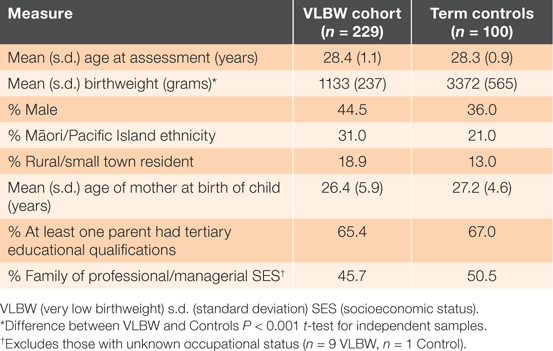
|
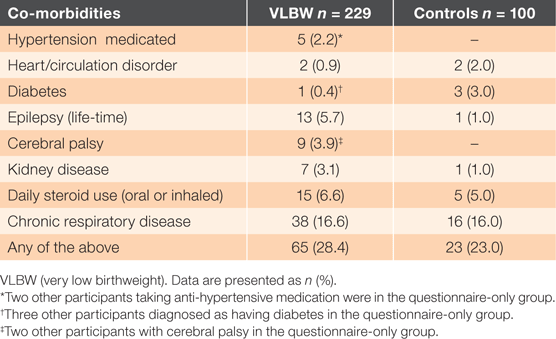
|
Table 3 shows self-reported health problems and GP contacts in the past 12 months, hospital visits or admissions in the past 5 years and the proportion taking prescribed medication on a regular basis. VLBW adults were slightly less likely to have attended their GP (P = 0.043) and to rate their overall health as very good or excellent (P = 0.046). Table 4 shows VLBW adults had slightly less favourable scores for general physical health and physical functioning compared with controls.
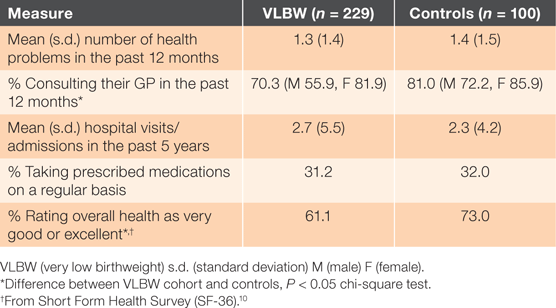
|
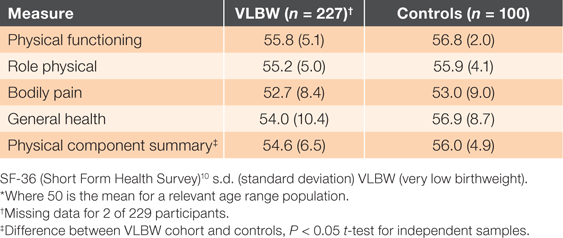
|
When asked, 77% of the VLBW cohort could name their GP or health centre (76% of males, 79% of females) compared with 90% of controls (84% of males, 94% of females). For participants who were unable to name their GP, we still generated a letter when necessary and asked the participants to tell us where to send it, which most subsequently did.
A letter to the GP was required for 101 (44.1%) VLBW (49 males) participants and 38% (14 males) controls (P = 0.30). The abnormal results triggering the letter to the GP are shown in Table 5.
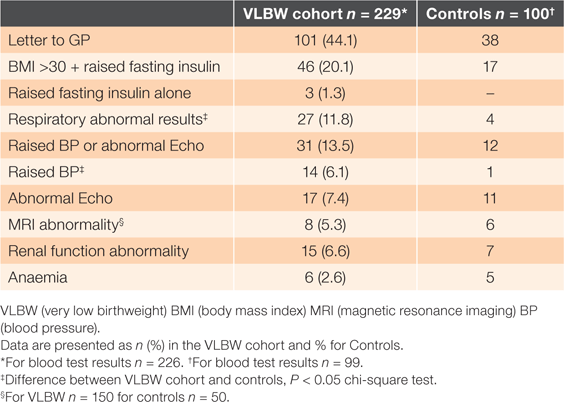
|
The most frequent reason for referral was a BMI >30 plus a fasting insulin >80 pmol/L. There were three VLBW participants who had a raised fasting insulin but were not obese, by itself not meeting criteria for referral, but these individuals also had respiratory problems and were referred to their GP on those grounds.
Respiratory problems occurred significantly more frequently in the VLBW group than the control group. All but two VLBW adults referred because of respiratory problems were smokers, as were three of four controls (overall 31% of VLBW and 21% of controls (P = 0.06) were current smokers). In the VLBW cohort, 15 participants were referred with moderate respiratory obstruction and 18 with a DLCO below the lower limit of normal, suggesting reduced gas exchange efficiency, and seven with both obstruction and a low DLCO. In the control group, three participants were referred with a low DLCO.
Hypertension was significantly more frequent in the VLBW cohort than controls. Among the 17 VLBW adults with abnormal echocardiograms, the most frequent findings were valve abnormalities (n = 4), right ventricular dilatation (n = 4) and left ventricular wall thickening, with or without some functional impairment, and concerns about hypertrophic cardiomyopathy (n = 5). Eleven of the control group had abnormal echocardiograms, including valve abnormality (n = 1), persistent ductus arteriosus (n = 1), right ventricular dilatation (n = 3) and left ventricular wall thickening (n = 4).
Cerebral MRI findings in the VLBW cohort resulting in referral were focal white matter hyperintensities plus concerns about multiple sclerosis (n = 2), focal abnormalities possibly indicating a tumour (n = 2), malformations (n = 3) and a pineal cyst (n = 1). In the control group, the incidental findings were focal white matter hyperintensities (n = 1) and focal abnormalities possibly indicating a tumour (n = 2).
In another 24 (10.6%) VLBW young adults and 6% of controls, the feedback letter to the participant specifically advised they see their GP about a health issue. In 19/24 of the VLBW participants and all six controls, the health issue was mild or moderately abnormal respiratory function tests together with either smoking or obesity or both. Hence, overall, 55% of the VLBW cohort and 44% of controls (P = 0.077) had some previously unknown or known-but-unmet physical health problems warranting consultation with a GP.
Discussion
In this research project assessing the physical health and wellbeing of a national cohort of VLBW young adults and term-born controls, we found that unrecognised or unmet physical health issues were common in both groups at 44% and 38% respectively, while another 10.6% and 6.0% had milder unmet problems.
In some cases, the health issue was accompanied by symptoms, typically shortness of breath and reduced exercise capacity, but the young person had not sought a medical opinion. In other cases, such as hypertension, there were no obvious symptoms, but the problem could have been readily detected at a routine health check. Other cases could only be detected by specialised investigations such as a cerebral MRI scan which, outside of a research protocol, would normally only be undertaken if medically indicated.
The VLBW and control groups were broadly comparable in terms of sex, ethnicity, residence and socioeconomic background. Controls had a similar profile of characteristics (education, employment, health-care utilisation) to national data for same age peers (data not shown).
The most frequent unrecognised or unmet health problem in both groups was obesity with a raised fasting insulin. We have previously reported the mean BMI in the VLBW cohort (males 26.5, females 27.0) and controls (males 26.4, females 29.2);13 the latter being broadly similar to New Zealand Health Survey data (males 28.0, females 28.4).2 Our feedback to the participants was that they had an increased risk of developing type 2 diabetes and they were advised to discuss this with their GP.
The VLBW participants were significantly more likely than controls to have unrecognised or unmet respiratory problems and in both groups, nearly all these individuals were smokers. Surviving very preterm infants have been shown to have a reduction in peak lung function,14 and more airways obstruction and gas trapping as young adults than controls, particularly if they have a history of bronchopulmonary dysplasia, as did 21% of the present cohort.7,14 The natural decline in lung function from peak at around age 20 years may lead to chronic respiratory symptoms at an early age, especially if decline in function is exacerbated by additional insults such as smoking.14 A UK survey found that adult respiratory specialists infrequently asked details of birth history in patients beyond childhood,15 and despite few data, it is likely that such questions are even less common in primary care.16 If this history was known to a primary care physician, it might trigger an earlier detailed review of respiratory function.
Six percent of the VLBW cohort had BP measurements in the hypertensive range versus 1% of the controls. A higher systolic BP in former VLBW or very preterm young adults than in controls has been described in several studies,17,18 and early detection may facilitate interventions including lifestyle changes.18 Other studies have recently reported increased left ventricular wall mass and reduced ventricular volume in these young adults.19 At present, the long-term consequences of these acquired changes are uncertain, although a history of very preterm birth will help to differentiate from the well-described and usually inherited condition of hypertrophic cardiomyopathy.20
The prevalence of incidental findings on a cerebral MRI scan will depend on the MRI field strengths and scanning protocols and the ages of the subjects. Cerebral MRI scans in healthy adult participants reveal incidental findings with health implications on average in ~3%,21 similar to our data. Cranial MRI scans undertaken on 2536 healthy male applicants to the German Air Force at mean age 20.5 years revealed 1.7% to have arachnoid cysts, 0.51% vascular abnormalities and 0.47% intracranial tumours.22 Diffuse white matter hyperintensities are reported in over 50% of cranial MRI scans at term equivalent in extremely preterm (<28 weeks’ gestation) infants,23,24 although the long-term implications are uncertain.23,25 In the three cases documented here, focal white matter hyperintensities were commented on in the clinical report and the possibility of multiple sclerosis was questioned.
There are few surveys of general health in New Zealand young adults. Denny et al. surveyed a random sample of 9107 secondary school students in 2007, reporting that 17% had not seen a doctor or nurse when indicated in the previous 12 months.26 However, many of the indicated conditions related to mental or sexual health, which have not been considered in our study. Issues of health-care access among young adults aged 18–24 years in 11 high-income countries, including New Zealand, compared with the experience of older adults, including the 25- to 34-year age bracket, have been reported.27 New Zealand was one of three countries where there were no differences between young and older adults’ responses regarding their health-care experience, with 22% of both age groups saying cost was a barrier to care.
Given the prevalence of unrecognised and unmet health needs in these young adults, there may be value in one or more general health checks being conducted when people are at school-leaving age or age 30 years. A Cochrane review of 14 randomised trials (182,880 participants), where general health checks were offered (versus none), found little benefit and no reduction in mortality or morbidity from either cardiovascular disease or cancer, although the number of new diagnoses did increase.28 Possible harms of this approach might include unnecessary tests for conditions unlikely to cause harm and a lack of cost effectiveness.
There are some weaknesses in our study. It was designed to assess young adult health and welfare outcomes following VLBW birth compared with term-born controls rather than the prevalence of unrecognised or unmet health problems, and the number of participants (329) would need to be greater to adequately address the latter question. The criteria used to define a significant health problem, triggering a letter, were somewhat arbitrary. We have little information, and none was collected systematically, on whether participants did actually see their GP, or the outcome of that review.
In conclusion, we have identified a high prevalence of unrecognised and unmet health problems in former VLBW young adults and term-born controls attending a health assessment for a research project. VLBW young adults more frequently had respiratory problems and raised BP than controls. Greater understanding of the life-long health consequences of very preterm birth should facilitate strategies to prevent or ameliorate adverse outcomes, and neonatal follow-up clinics can raise parental awareness of the issues, such as the importance of not smoking. Continuity of care is important for VLBW young adults who we believe should have a regular GP. We agree with others16 that GPs should routinely include inquiry about their gestation and birthweight when seeing young adults and that VLBW and very preterm graduates should volunteer this information.
COMPETING INTERESTS
The authors declare no competing interests.
ACKNOWLEDGEMENTS
The study was funded by a project grant from the New Zealand Health Research Council (12-129) with additional funding from Cure Kids, and project grants from the Child Health Research Foundation (CHRF 5040 and CHRF 5041). We are grateful to Judy Heslop and Lorraine Skelton who contributed to data collection. We thank all of the young adult participants for their willingness to take part in this study.
References
[1] Aarseth S, Dalen I, Haavet OL. Encouraging adolescents to contact their GP: a community-based trial. Br J Gen Pract. 2014; 64 e262–7.| Encouraging adolescents to contact their GP: a community-based trial.Crossref | GoogleScholarGoogle Scholar | 24771839PubMed |
[2] Ministry of Health. Annual Data Explorer 2016/17: New Zealand Health Survey [Data File]. Wellington: Ministry of Health; 2017 [cited 2018 December 31]. Available from: https://minhealthnz.shinyapps.io/nz-health-survey-2016-17-annual-data-explorer/_w_15542d9e/#!/home.
[3] Denny S, de Silva M, Fleming T, et al. The prevalence of chronic health conditions impacting on daily functioning and the association with emotional well-being among a national sample of high school students. J Adolesc Health. 2014; 54 410–5.
| The prevalence of chronic health conditions impacting on daily functioning and the association with emotional well-being among a national sample of high school students.Crossref | GoogleScholarGoogle Scholar | 24210897PubMed |
[4] Crump C, Sundquist K, Sundquist J, Winkleby MA. Gestational age at birth and mortality in young adulthood. JAMA. 2011; 306 1233–40.
| Gestational age at birth and mortality in young adulthood.Crossref | GoogleScholarGoogle Scholar | 21934056PubMed |
[5] Crump C, Winkleby MA, Sundquist K, Sundquist J. Risk of hypertension among young adults who were born preterm: a Swedish national study of 636,000 births. Am J Epidemiol. 2011; 173 797–803.
| Risk of hypertension among young adults who were born preterm: a Swedish national study of 636,000 births.Crossref | GoogleScholarGoogle Scholar | 21320866PubMed |
[6] Crump C, Winkleby MA, Sundquist J, Sundquist K. Risk of asthma in young adults who were born preterm: a Swedish national cohort study. Pediatrics. 2011; 127 e913–20.
| Risk of asthma in young adults who were born preterm: a Swedish national cohort study.Crossref | GoogleScholarGoogle Scholar | 21422091PubMed |
[7] Raju TNK, Buist AS, Blaisdell CJ, et al. Adults born preterm: a review of general health and system-specific outcomes. Acta Paediatr. 2017; 106 1409–37.
| Adults born preterm: a review of general health and system-specific outcomes.Crossref | GoogleScholarGoogle Scholar | 28419544PubMed |
[8] Darlow BA, Horwood LJ, Woodward LJ, et al. The New Zealand 1986 very low birth weight cohort as young adults: mapping the road ahead. BMC Pediatr. 2015; 15 90
| The New Zealand 1986 very low birth weight cohort as young adults: mapping the road ahead.Crossref | GoogleScholarGoogle Scholar | 26242407PubMed |
[9] Bunin GR, Vardhanabhuti S, Lin A, et al. Practical and analytical aspects of using friend controls in case-control studies: experience from a case-control study of childhood cancer. Paediatr Perinat Epidemiol. 2011; 25 402–12.
| Practical and analytical aspects of using friend controls in case-control studies: experience from a case-control study of childhood cancer.Crossref | GoogleScholarGoogle Scholar | 21819422PubMed |
[10] Ware J Jr, Kosinski M, Gandek B. SF-36 Health Survey: Manual & Interpretation Guide. Lincoln, RI, United States: QualityMetric, Inc.; 2005.
[11] Burney PGJ, Luczynska C, Chinn S, Jarvis D. The European Community Respiratory Health Survey. Eur Respir J. 1994; 7 954–60.
| The European Community Respiratory Health Survey.Crossref | GoogleScholarGoogle Scholar |
[12] Graham BL, Brusasco V, Burgos F, et al. 2017 ERS/ATS standards for single-breath carbon monoxide uptake in the lung. Eur Respir J. 2017; 49 1600016
| 2017 ERS/ATS standards for single-breath carbon monoxide uptake in the lung.Crossref | GoogleScholarGoogle Scholar | 28049168PubMed |
[13] Darlow BA, Martin J, Horwood LJ. Metabolic syndrome in very low birth weight young adults and controls: the NZ 1986 VLBW study. J Pediatr. 2018;
| Metabolic syndrome in very low birth weight young adults and controls: the NZ 1986 VLBW study.Crossref | GoogleScholarGoogle Scholar | 30545563PubMed |
[14] Gibson AM, Doyle LW. Respiratory outcomes for the tiniest or most immature infants. Semin Fetal Neonatal Med. 2014; 19 105–11.
| Respiratory outcomes for the tiniest or most immature infants.Crossref | GoogleScholarGoogle Scholar | 24239022PubMed |
[15] Bolton CE, Bush A, Hurst JR, et al. Are early life factors considered when managing respiratory disease? A British Thoracic Society survey of current practice. Thorax. 2012; 67 1110
| Are early life factors considered when managing respiratory disease? A British Thoracic Society survey of current practice.Crossref | GoogleScholarGoogle Scholar | 22993167PubMed |
[16] Crump C. Medical history taking in adults should include questions about preterm birth. BMJ. 2014; 349 g4860
| Medical history taking in adults should include questions about preterm birth.Crossref | GoogleScholarGoogle Scholar | 25085466PubMed |
[17] Parkinson JRC, Hyde MJ, Gale C, et al. Preterm birth and the metabolic syndrome in adult life: a systematic review and meta-analysis. Pediatrics 2013; 131 e1240–63.
| Preterm birth and the metabolic syndrome in adult life: a systematic review and meta-analysis.Crossref | GoogleScholarGoogle Scholar |
[18] Kajantie E, Hovi P. Is very preterm birth a risk factor for adult cardiovascular disease? Semin Fetal Neonatal Med. 2014; 19 112–7.
| Is very preterm birth a risk factor for adult cardiovascular disease?Crossref | GoogleScholarGoogle Scholar | 24332842PubMed |
[19] Nuyt AM, Lavoie JC, Mohamed I, et al. Adult consequences of extremely preterm birth: cardiovascular and metabolic diseases risk factors, mechanisms, and prevention avenues. Clin Perinatol. 2017; 44 315–32.
| Adult consequences of extremely preterm birth: cardiovascular and metabolic diseases risk factors, mechanisms, and prevention avenues.Crossref | GoogleScholarGoogle Scholar | 28477663PubMed |
[20] Maron BJ, Maron MS. Hypertrophic cardiomyopathy. Lancet. 2013; 381 242–55.
| Hypertrophic cardiomyopathy.Crossref | GoogleScholarGoogle Scholar | 22874472PubMed |
[21] Wardlaw JM, Booth TC, Laurie G, et al. Acting on incidental findings in research imaging. BMJ. 2015; 351 h5190
| Acting on incidental findings in research imaging.Crossref | GoogleScholarGoogle Scholar | 26556813PubMed |
[22] Weber F, Knopf H. Incidental findings in magnetic resonance imaging of the brains of healthy young men. J Neurol Sci. 2006; 240 81–4.
| Incidental findings in magnetic resonance imaging of the brains of healthy young men.Crossref | GoogleScholarGoogle Scholar | 16256141PubMed |
[23] Dyet LE, Kennea N, Counsell SJ, et al. Natural history of brain lesions in extremely preterm infants studied with serial magnetic resonance imaging from birth and neurodevelopmental assessment. Pediatrics. 2006; 118 536–48.
| Natural history of brain lesions in extremely preterm infants studied with serial magnetic resonance imaging from birth and neurodevelopmental assessment.Crossref | GoogleScholarGoogle Scholar | 16882805PubMed |
[24] Skiöld B, Horsch S, Hallberg B, et al. White matter changes in extremely preterm infants, a population-based diffusion tensor imaging study. Acta Paediatr. 2010; 99 842–9.
| White matter changes in extremely preterm infants, a population-based diffusion tensor imaging study.Crossref | GoogleScholarGoogle Scholar | 20132144PubMed |
[25] Broström L, Bolk J, Padilla N, et al. Clinical implications of diffuse excessive high signal intensity (DEHSI) on neonatal MRI in school age children born extremely preterm. PLoS One 2016; 11 e0149578
| Clinical implications of diffuse excessive high signal intensity (DEHSI) on neonatal MRI in school age children born extremely preterm.Crossref | GoogleScholarGoogle Scholar | 26886451PubMed |
[26] Denny S, Farrant B, Cosgriff J, et al. Forgone health care among secondary school students in New Zealand. J Prim Health Care. 2013; 5 11–8.
| Forgone health care among secondary school students in New Zealand.Crossref | GoogleScholarGoogle Scholar | 23457690PubMed |
[27] Hargreaves DS, Greaves F, Levay C, et al. Comparison of health care experience and access between young and older adults in 11 high-income countries. J Adolesc Health. 2015; 57 413–20.
| Comparison of health care experience and access between young and older adults in 11 high-income countries.Crossref | GoogleScholarGoogle Scholar | 26205758PubMed |
[28] Krogsbøll LT, Jørgensen KJ, Grønhøj Larsen C, Gøtzsche PC. General health checks in adults for reducing morbidity and mortality from disease. Cochrane Database Syst Rev. 2012; 10 CD009009
| 23076952PubMed |


